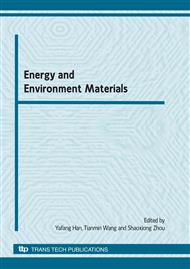p.150
p.157
p.163
p.168
p.172
p.178
p.186
p.193
p.199
Degradation Behavior of MgB2 Powders in Different Medium Environment
Abstract:
High purity MgB2 powders were synthesized by solid sintering reaction. The degradation behavior of MgB2 powders in deionized water was investigated. XRD and SEM analysis indicate that the changes of MgB2 are a function of time. XRD patterns show that the lattice constants are increasing with the time, and MgB2 samples mostly contain amorphous phase after water treated. The decomposition reaction equation was obtained based on the IR and mass spectrum results. The changes of MgB2 exposed to the 10%HCl, 10%H2SO4, 10%NaOH, 1%HCl, 1%H2SO4 and 1%NaOH (mole concentration) were also studied. The variation of phase composition and morphology indicate that the small amount of MgB2 has decomposed on some extent. The results show that acid can catalyze the decomposition of MgB2 but inversely alkali inhibits the decomposition. The decomposition reaction is limited in water, acid and alkali for less than 1h, and it could be said that the stability of MgB2 is better under such conditions.
Info:
Periodical:
Pages:
172-177
Citation:
Online since:
May 2010
Authors:
Keywords:
Price:
Сopyright:
© 2010 Trans Tech Publications Ltd. All Rights Reserved
Share:
Citation:


